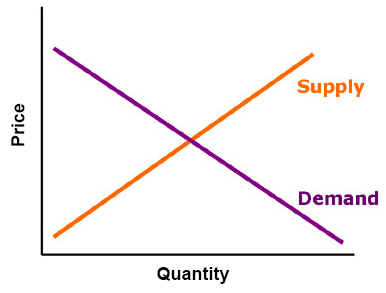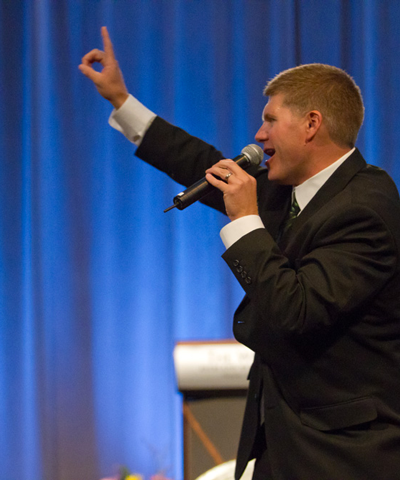As you prepare items for your nonprofit’s next silent auction fundraiser, you would be inclined to think more is better. After all, who doesn’t want table after table of auction items for donors to bid on? More items means more bids means more money… right??
Well, not really. In fact, having too many items can be counterproductive and actually hamper the performance of all the items in your silent auction.
Problem: Having more auction items than bidders
Offering guests too many silent auction items can cause decision-making fatigue, where guests end up shopping too much – instead of actually placing bids. Just like a kid in a candy store, they spend all their time running around trying to pick their favorite instead of actually spending the money in their pocket.
With too much to choose from there is also less competition for each item. If there’s something for everyone, what’s the point of bidding?
For those who slept through Econ101 (guilty), this is one of the most fundamental concepts of economics: Supply and Demand. As the supply of something goes up, demand for it goes down and prices fall (In this case we’re referring to final sale price of a silent auction item). Conversely, as supply goes down, demand increases and the prices rise.
For example, if you put out only five silent auction items at an event with 300 guests, you can bet each item will generate plenty of bidding activity. On the other hand, if you have two auction items for every guest in the room – i.e. waaay too many items – most people are going to only place a single bid. Most patrons are charitable, yes, but they are also bargain hunters. They won’t typically bid any more then they have to.
When you have such a high supply of auction items to choose from and bid on, the demand for these items plummets. This is what’s called a “buyer’s market.” As the auction committee, you want to avoid creating a buyer’s market at all costs, because it can severely limit your return on the auction as a whole.
When it comes to silent auctions, it’s actually better to create the opposite of a buyer’s market. In a “seller’s market,” you create a sense of scarcity so guests feel like they’re competing with each other. You want them to feel like they are going to miss out if they don’t place their bids NOW.
To do this you have to reduce the number of auction items relative to the size of your guest list. Doing this will help you maximize the return on each auction item and consequently, from the event as a whole.
{{cta(‘8ee7d503-c9ba-4b63-83cd-0d389f063597′,’justifycenter’)}}
How many auction items should I have?
The ideal number of silent auction items is based on how many “buying units” are in the room. A buying unit is equivalent to one decision maker. Couples, for example, are counted as one buying unit. Single attendees, such as those who attend with a group of friends, are each counted as individual buyer units.
You want half as many auction items as buying units at your event. To figure out how many buying units you should expect, look at your guest list and add up how many couples and singles will be in attendance, then divide that number by two.
For example, if your guest list of 200 people has 80 couples (160 people), there will be roughly 40 people attending by themselves (200 total – 160 people who are coupled = 40 singles). Add up the number of couples (80) and singles (40) and you have the total number of estimated buying units (120). Take this and cut it in half to get your target for the silent auction. In this case, it would be 60 auction items.
Keep in mind this is an estimate. It doesn’t have to be precise since you may not know exactly how many people will show up.
That said, trust this number! Using this formula to determine the size of your silent auction helps you to maximize the buying power of your audience instead of diluting it. You are creating a sense of urgency and building competition to help drive up the bidding and ultimately raise more for your cause.
What if I have too many items?
A good problem to have, right?! Well, yes. But it can turn into quite a headache when you find yourself with hundreds of extra items. In this case, the best solution is to begin creatively bundling your small to medium-sized items into larger themed packages.
Bundling not only increases the aggregate value of the combined items, it also makes it easier to manage during the auction. Fewer items means fewer bid sheets and less time your donors have to spend at check out.
Here are some examples of bundling silent auction item packages to maximize their value:
- “Dine Around Town” or “A Taste of Hometown” – Combine a variety of restaurant gift certificates into a larger dining-themed package.
- “Family Zoo Package” – Include admissions for 3 people to a local zoological park and several stuffed animals. The package could be expanded to include breakfast or dinner or even include other items like a digital camera, safari hat and water bottle.
- “Car Care Kit” – A year of oil changes with a bucket of car cleaning supplies, a car wash gift certificate or other auto related items.
- “Romantic Night for Two” – Guaranteed to get a lot of attention. Include a certificate for an upscale dinner, bottle of wine with glasses, movie or live theatre tickets and perhaps a night at a local hotel. You can take it a step further for parents by including a few certificates for pizza and a coupon for a night of babysitting.
- “Life Experiences” – Include tickets to a ball game, a stadium tour, a chance to throw out the first pitch and perhaps an autographed bat or ball. See if you can procure helicopter ride from the local sheriff’s department (shoot for the moon!) or television news station behind-the-scenes tour.
- “Vacation Package” – Include airfare, hotel, and an iconic experience at that destination. Example destinations include Napa Valley, Broadway in NYC or the Nashville music scene. Many corporate clients who don’t have the ability to donate a product or service may be willing to underwrite the cost of a no-risk travel package to include in your silent auction.
Can I have too few items?
Absolutely. You want to have enough items so everyone in your audience can participate. With too few items, the bidding would quickly surpass what the average person in the room can afford. People can be priced out of the auction before they have a chance to compete.
Furthermore, having too few items will give the appearance you weren’t successful at getting enough items donated. If winning an auction item becomes too difficult it can create disappointment. If people who had intentions of making a donation are unable to purchase an auction items, that translates to money walking out the door.
The best way to avoid this is by using the buyer’s unit calculation to figure out the optimal number of items. Trust this number! Bundle items together as best you can to whittle down your offering to meet it.
What should I do with extra items?
Extra items can be sold in an online edition of your auction, raffled off at your event, used in a live auction or be held back for a future event. They can even be sold after your event to interested parties. Having “too many” items isn’t a bad thing. It’s just a matter of utilizing the excess in a different way, while still contributing to your fundraising goals.
 What about the live auction?
What about the live auction?
Some of these concepts can also be applied to the live auction, which many benefit auctioneers do naturally as part of their presentation. To create a “seller’s market” during the live auction, auctioneers make sure the audience understands exactly how many items will be sold. Update your bidders on how many items are left as the auction progresses.
Auctioneers will also “tease” with larger items like vacation packages to build interest. You can also play around with selling multiples, where you can sell one item to multiple bidders (such as the top three bidders) and multiply the revenue generated on a single item. Bundled and themed packages work well in live auctions.
Like your silent auction, too many items can make a live auction drag on and lead to lack of interest and enthusiasm. Keep your live auction short and sweet – we recommend limiting it to 7-12 items – to keep your audience engaged and to maximize the return on the items you are presenting.
Like in many other areas of operation and event planning, nonprofits must make the most out of their resources. Strategically plan your silent auction items to maximize the excitement and bidding!
{{cta(‘ace6904c-d5a9-4f23-afcc-36e09cf0f71e’,’justifycenter’)}}





 What about the live auction?
What about the live auction?